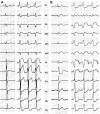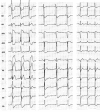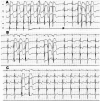Mahaim fibre tachycardia: recognition and management
- PMID: 16943957
- PMCID: PMC1513516
Mahaim fibre tachycardia: recognition and management
Figures









Similar articles
-
The automaticity of Mahaim fibre and its response to effective ablation.Chin Med J (Engl). 2004 Dec;117(12):1768-71. Chin Med J (Engl). 2004. PMID: 15603702
-
Electrophysiology study and radiofrequency catheter ablation of atriofascicular tracts with decremental properties (Mahaim fibre) at the tricuspid annulus.Europace. 2008 Dec;10(12):1428-33. doi: 10.1093/europace/eun283. Epub 2008 Oct 19. Europace. 2008. PMID: 18936042 Clinical Trial.
-
Latent Mahaim fiber as a cause of antidromic reciprocating tachycardia: recognition and successful radiofrequency ablation.J Cardiovasc Electrophysiol. 2002 Jan;13(1):74-8. doi: 10.1046/j.1540-8167.2002.00074.x. J Cardiovasc Electrophysiol. 2002. PMID: 11843488
-
Mahaim tachycardias.Eur Heart J. 1998 May;19 Suppl E:E25-31, E52-3. Eur Heart J. 1998. PMID: 9717021 Review.
-
[Mahaim fiber tachycardia and re-entry tachycardia through decremental atrioventricular accessory pathways with anterograde unidirectional block].Cardiologia. 1999 Dec;44 Suppl 1(Pt 1):453-5. Cardiologia. 1999. PMID: 12497951 Review. Italian. No abstract available.
Cited by
-
A single Mahaim accessory pathway with bidirectional delta waves.HeartRhythm Case Rep. 2019 Apr 24;5(7):379-381. doi: 10.1016/j.hrcr.2019.04.004. eCollection 2019 Jul. HeartRhythm Case Rep. 2019. PMID: 31341781 Free PMC article. No abstract available.
-
Not Just a One-Way: Mahaim Accessory Pathway Concomitantly Supporting Orthodromic Atrioventricular Re-Entrant Tachycardia.J Clin Med. 2022 Dec 25;12(1):159. doi: 10.3390/jcm12010159. J Clin Med. 2022. PMID: 36614960 Free PMC article.
-
Comprehensive assessment of Mahaim accessory pathways' anatomic distribution.J Int Med Res. 2022 Jan;50(1):3000605211069751. doi: 10.1177/03000605211069751. J Int Med Res. 2022. PMID: 35001697 Free PMC article.
-
Spontaneous automaticity arising from a successfully ablated Mahaim fiber.J Interv Card Electrophysiol. 2007 Nov;20(1-2):25-8. doi: 10.1007/s10840-007-9164-3. Epub 2007 Oct 18. J Interv Card Electrophysiol. 2007. PMID: 17943429
References
-
- Gallagher JJ, Smith WM, Kassell JH, et al. Role of Mahaim fibers in cardiac arrhythmias in man. Circulation. 1981;64:176–189. - PubMed
-
- Benatt Mahaim I. Nouvelles recherches sur les connexions superiors de la branche gauche du faisceau de His-Tawara avec cloison interventriculaire. Cardiologia. 1938;1:61–120.
-
- Mahaim I. Kent's fibers and the A-V paraspecific conduction through the upper connections of the bundle of His-Tawara. Am Heart J. 1947;33:651. - PubMed
-
- Lev M, Gibson S, Miller RA. Ebstein's disease with Wolff-Parkinson-White syndrome. Am Heart J. 1955;49:724. - PubMed
-
- Becker AE, Anderson RH, Path MRC, et al. The anatomical substrates of Wolff-Parkinson-White syndrome: a clinic-pathologic correlation in seven patients. Circulation. 1978;57:870–879. - PubMed
LinkOut - more resources
Full Text Sources
